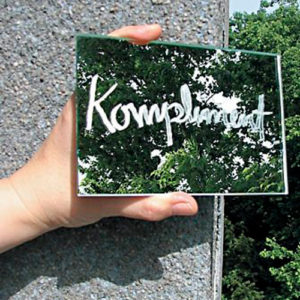 Kompliment (Compliment)
Kompliment (Compliment)
Kirsten Klöckner
11 cm x 15 cm
1999
Mirror, engraved
Edition: unlimited, numbered, signed
If our last artwork of the month by Lourdes de la Riva was ephemeral, the artwork of this month is all but volatile. Nevertheless, it isn’t locatable at a certain place, due to its conception as multiple.
Kirsten Klöckner conceived “Kompliment” (Compliment) in 1999 as an unlimited edition. By now, the number of the circulation accounts to over 1000 pieces. Each is a mirror, white lacquered at its back, with the hand-made engraving “Kompliment” on the obverse. Every time one looks into the mirror, one can read compliment and apply it to oneself.
However, the compliment comes a little bit clumsy to the on viewer. To point on the difficulty to express an admiring comment in the right way, Kirsten engraves the word freehand with her left. That reflects the problem to express a positive approval just like to receive it without provoking any thoughts of dishonesty. Every here and now, a compliment could be serious or ironic. In any case, the artist’s intention is affirmative. The beholder could admire him/herself and accept the positive support. This could be a daily mood enhancer.
Here is the key feature in the conception of “Compliment”: it is a multiple. By its characteristic, a multiple is part of a limited or unlimited, artist-authorised series. Every piece is an original and at the same time a component of a greater artwork and the idea to make art accessible for everyone.
Although the principle of serial art production and its large distribution started with the possibility of printing, there was always the hierarchy of original and copy. Walter Benjamin even feared in 1935 the loss of the oeuvre’s aura in the age of mechanical reproduction. At the same time, he had the advantages and disadvantages for the masses in view. Whereas the after-war artist generation raised the serial production in the 1960s and 70s of artworks to a certain standard. Multiplied art boomed.
Born as well by the will to earn money independently from established galleries, there was a huge theoretical background to democratise the art market and liberate the access to art. In these years artists developed diverse forms of self-management, which included not only the organisation of often-participative art events and artist-run art spaces, but also the self-distribution of the oeuvres. Numerous publishing houses were founded. A constituting element was the sale of multiples at relatively low prices. Therefore, the profile of buyers changed, too. Now it was possible to purchase for example the “Intuition Box” by Joseph Beuys for only 8 Deutsche Mark (today around 4 Euro). It became art for everyone.
By the principle of the multiple the hierarchy between original and copy is repealed. Its value is not any longer established by its uniqueness, but by the existence of the series. A single piece of an edition of multiples is not a reproduction of an original, which does no longer exists. The oeuvres interrelate equally to each other. Every single multiple summarise all the others as idea and the idea of the multiple in total.
Kirsten stands with her creation of multiples and the self-distribution by her own independent publishing company in the theoretical and practical tradition of artistic discourse of the ’68 generation. She currently enables over 1000 people to be part of greater artwork and receive her compliments as often as they wish.
Kirsten Klöckner
Born 1962 in Braunschweig, Germany, Kirsten lives and works in Berlin since 2002. From 1983 to 1986 she studied sculpture at the Academy of Fine Arts (Kunstakademie), Münster. 1990 she opened the edition-gallery “Edition Klöckner” in Düsseldorf. Here she publishes graphics and multiples inter alia from A.R. Penck, Sigmar Polke, Klaus Staeck. Besides, she offers her own multiples and paintings (as original, graphic print or postcard) and books about her artistic projects.
Kirsten’s works have been shown in many personal and group exhibitions. Moreover, her works are in several major art collections, for example in the Kunstmuseum am Ehrenhof Düsseldorf (heute Museum Kunstpalast), Sammlung Falckenberg, Hamburg and the art collection of the Landesbank Baden-Württemberg.
In addition to the creation of various multiples, Kirsten is a painter. Here her main medium are large-sized lacquered and often vivid pigmented watercolours. Since 2012 she works on the series BeuteKunst (looted art), meanwhile consisting of three parts with different sources of inspiration. Our artwork of the month of March 2015 was from BeuteKunst III. Another desired image, “Toleranzvirus” (Tolerance-Virus) became an award for people, who are in a particular way engaged for tolerance in our society by the association Aproto.
Currently, Kirsten’s oeuvres are part of the exhibition “We All Love Art” conceived by Ryszard Waśko. The show at Schlachthaus.fresh & fine art @ SevenStarGallery, Berlin, is on view until the 16th July 2017.
www.facebook.com/kirsten.kloeckner
